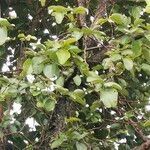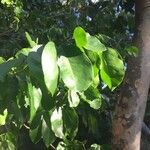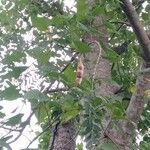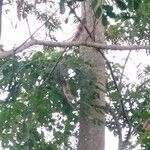Tree to 30 m tall; branchlets glabrous or nearly so. Bark usually smooth with numerous pustular lenticels and oval to oblong patches exfoliating to leave shallow depressions. Leaves: petiole 0.8–5 cm long; rachis 0–9.5 cm long; leaflets usually in (1–) 2 (–3) pairs, asymmetrically ovate to elliptic or rotund, 4–16 cm long, 3–11 cm wide, rounded to obtuse or obtusely pointed or emarginate apically, glabrous throughout or with hairs on one or both sides of midrib on lower surface, venose. Flowers in dense corymbose panicles 3–10 cm long, 4–12 cm wide, on slender, finely pubescent pedicels. Hypanthium 6–10 mm long; sepals oblong-elliptic, 6–13 mm long, finely pubescent. Petal 1.3–3.3 cm long, long-clawed, white turning pink; lamina 1–3.4 cm wide. Stamens red. Pods oblong, compressed, 10–28 cm long, 4–7.2 cm wide. Seeds blackish but with a rusty scurf, 2.2–3.5 cm long, 1.5–3.2 cm wide, somewhat compressed.
A tree which grows along the foreshore. It is 30-50 m tall. The trunk can be 15 m long. It has small buttresses. The trunk can be 60-90 cm across. The bark peels off in circular flakes. The crown is spreading and leaves often fall off. The leaves are divided along the stalk. The leaf is 25 cm long. There are 2 pairs of leaflets. These leaflets are oval and often different on each side of the midrib. They are shiny green. They are 8-14 cm long by 6-11 cm wide. The flower panicle has many flowers densely together and they are at the end of a branch. The petals are often crinkled and can be white or red. The stamens are dark red. The flowers have a pleasant smell. The fruit is a pod which is oblong and flat. It has a short beak. There are veins along the valves. The pod is 14-28 cm long by 4-7 cm wide. There are 2-4 or more seeds which are flat and 2-2.5 cm across.
Tree 5–40 m. high, buttressed when old; bark pale grey; young branchlets glabrous or nearly so.. Leaves glabrous (in East Africa); petiole with rhachis (1.5–)3.5–10.5 cm. long; leaflets in (l–)2, very rarely 3, pairs, asymmetrically ovate to elliptic or rotund, 4–16 cm. long, 2.8–11 cm. wide, rounded to obtuse or obtusely pointed at apex, venose.. Inflorescence a corymbose panicle 3–10 cm. long and 4–12 cm. wide.. Sepals 6–16 mm. long.. Petal 1, white or pink, 1.3–3.3 cm. long, long-clawed, with a crisped lamina 1–3.4 cm. wide.. Stamens red.. Pods 10–28 cm. long, 4–7.2 cm. wide.. Seeds 2.2–3.5 cm. long, 1.5–3.2 cm. wide, ± covered with detachable rusty scurf.. Fig. 23, p. 129.





